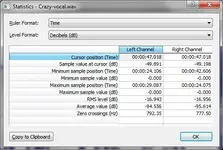S
ssroycal
New member
My home recording studio has configuration like this:
Hardware:
1. M-Audio Fast Track Pro - USB
2. Beta Three - Digital Delay DD2
3. Behringer Large Diaphragm Studio Condenser Microphone C-3
Software:
1. Sony Acid Pro 7.0
2. Sony Sound Forge Pro 10.0
Procedure I follow:
1. I use 48kHz, 24-bit audio for the Hardware & Software
2. I load the music track into AcidPro, and then dub the voice there
3. While voice recording through Behringer C-3 Condenser Microphone I use: Cardioid polar pattern, and activate the low cut filter.
4. I use Digital Delay DD2 – to put some delay/reverb effect online during recording
5. Then I render the Vocal track from AcidPro in 48kHz, 24bit WAV format.
6. Then I load both the Vocal & music track in SoundForge (both in 48kHz, 24bit WAV format)
7. Then I usually process the recorded vocal track like this:
a. I Normalize the recorded vocal track using, RMS, Normalize to: -14 dB, & 'Use equal loudness contour'
b. Then I put REVERB effect in the vocal track using, Deep Hall, Decay Time 2.0 sec, Pre –Delay 100 ms
c. Then I mix the vocal & music track, keeping the Vocal track FIXED at -3.0 dB, and setting the gain of the music track as I feel it should be according to the gain of the vocal track. Most of the cases I set the gain of the music track between -3.0dB to -10dB.
Here I’d like to mention that I am a vocalist and I don’t have any formal training on sound engineering. I learned these techniques through experiences only after a lot of trial & error. And the sample of the output I got using the above techniques & parameters can be found in the Attached .MP3 file
I just wanna ask you all in this forum that, in the procedure I am using for processing and mixing the audio – am I missing any vital thing and are there any tricks to make it much more better.
Please advise, Thanks in advance
~Sanjoy Sinharoy
Hardware:
1. M-Audio Fast Track Pro - USB
2. Beta Three - Digital Delay DD2
3. Behringer Large Diaphragm Studio Condenser Microphone C-3
Software:
1. Sony Acid Pro 7.0
2. Sony Sound Forge Pro 10.0
Procedure I follow:
1. I use 48kHz, 24-bit audio for the Hardware & Software
2. I load the music track into AcidPro, and then dub the voice there
3. While voice recording through Behringer C-3 Condenser Microphone I use: Cardioid polar pattern, and activate the low cut filter.
4. I use Digital Delay DD2 – to put some delay/reverb effect online during recording
5. Then I render the Vocal track from AcidPro in 48kHz, 24bit WAV format.
6. Then I load both the Vocal & music track in SoundForge (both in 48kHz, 24bit WAV format)
7. Then I usually process the recorded vocal track like this:
a. I Normalize the recorded vocal track using, RMS, Normalize to: -14 dB, & 'Use equal loudness contour'
b. Then I put REVERB effect in the vocal track using, Deep Hall, Decay Time 2.0 sec, Pre –Delay 100 ms
c. Then I mix the vocal & music track, keeping the Vocal track FIXED at -3.0 dB, and setting the gain of the music track as I feel it should be according to the gain of the vocal track. Most of the cases I set the gain of the music track between -3.0dB to -10dB.
Here I’d like to mention that I am a vocalist and I don’t have any formal training on sound engineering. I learned these techniques through experiences only after a lot of trial & error. And the sample of the output I got using the above techniques & parameters can be found in the Attached .MP3 file
I just wanna ask you all in this forum that, in the procedure I am using for processing and mixing the audio – am I missing any vital thing and are there any tricks to make it much more better.
Please advise, Thanks in advance
~Sanjoy Sinharoy
Attachments
Last edited:






